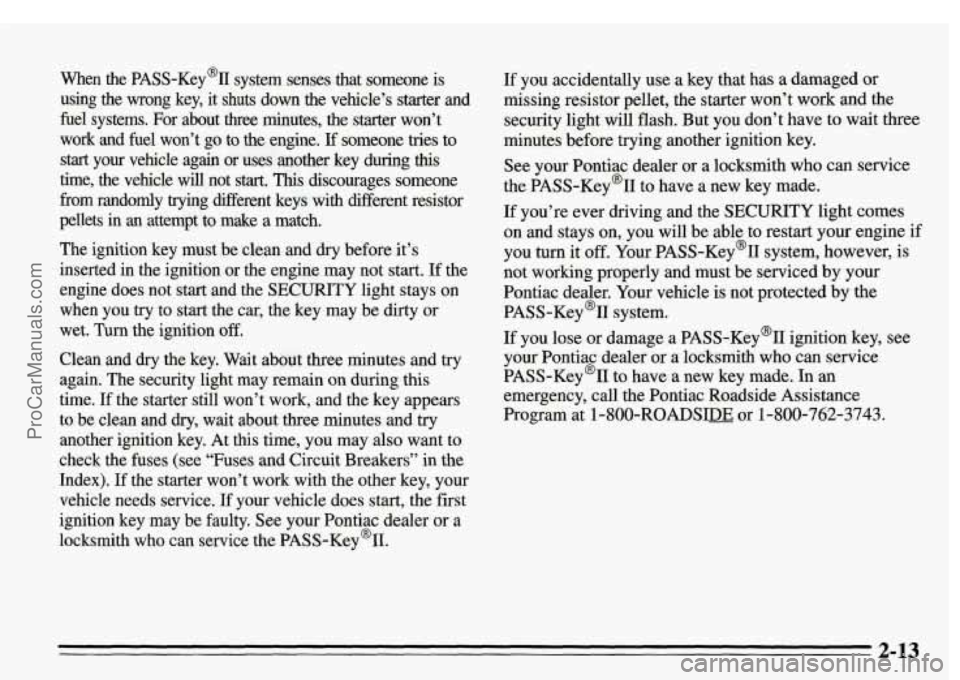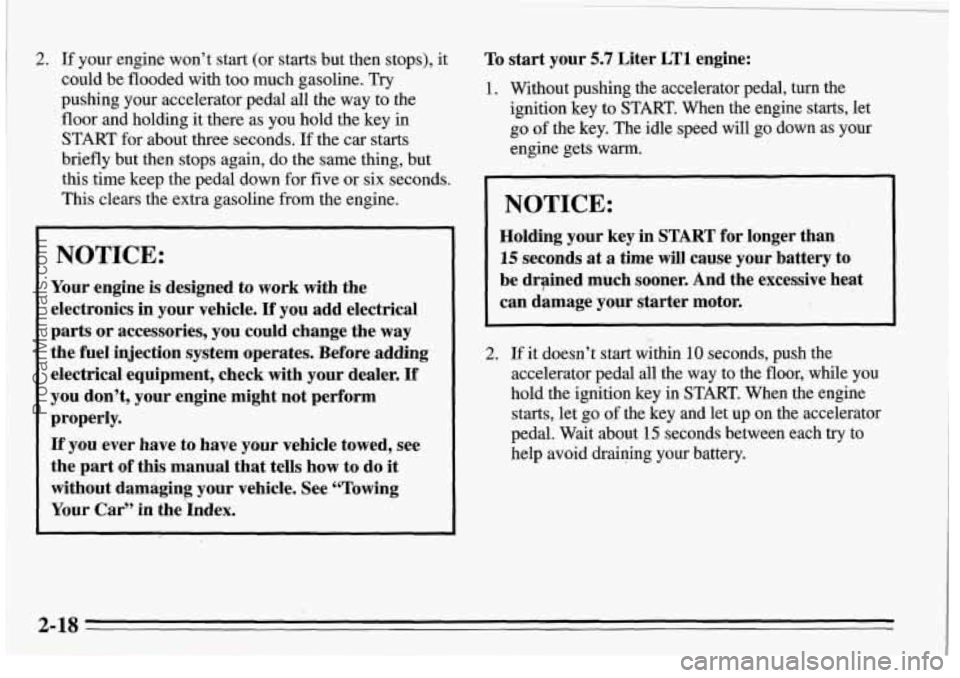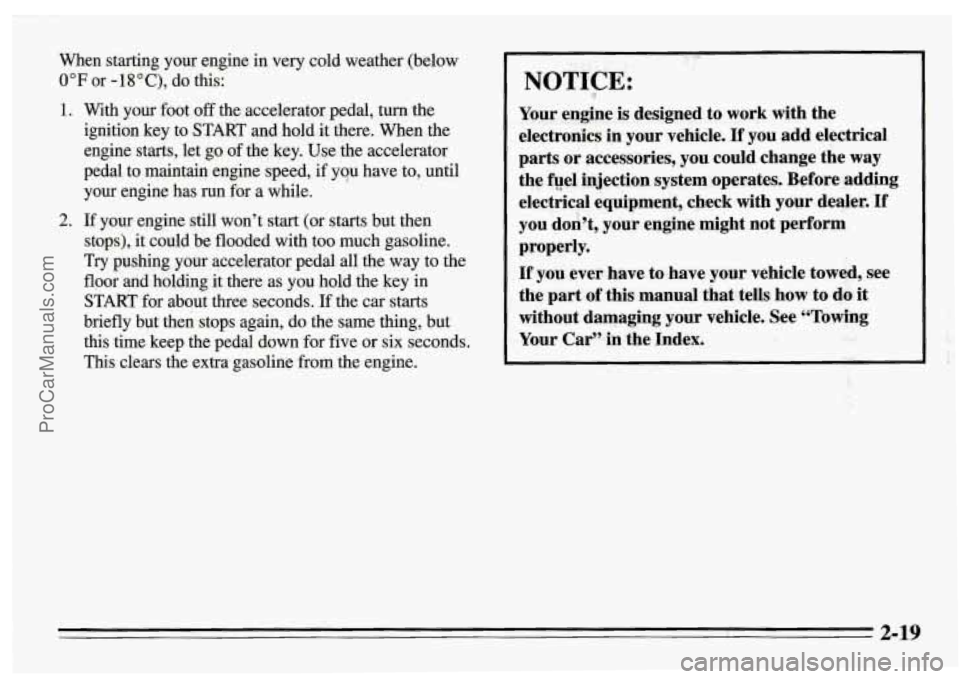check engine PONTIAC FIREBIRD 1995 Owners Manual
[x] Cancel search | Manufacturer: PONTIAC, Model Year: 1995, Model line: FIREBIRD, Model: PONTIAC FIREBIRD 1995Pages: 386, PDF Size: 19.66 MB
Page 60 of 386

When the PASS-Key(% system senses that someone is
using the wrong key, it shuts down the vehicle’s starter and
fuel systems. For about
three minutes, the starter won’t
work and fuel won’t
go to the engine. If someone tries to
start your vehicle again or uses another key during this
time, the vehicle will not start. This discourages someone
from randomly
trying different keys with different resistor
pellets in
an attempt to make a match.
The ignition key must be clean and dry before it’s
inserted in the ignition or the engine may not start. If the
engine does not start and the
SECURITY light stays on
when you
try to start the car, the key may be dirty or
wet.
Turn the ignition off.
Clean and dry the key. Wait about three minutes and try
again. The security light may remain on during this
time. If the starter still won’t work, and the key appears
to be clean
and dry, wait about three minutes and try
another ignition key. At this time, you may also want to
check the fuses (see “Fuses and Circuit Breakers” in the
Index).
If the starter won’t work with the other key, your
vehicle needs service.
If your vehicle does start, the first
ignition key may be faulty. See your Pontiac dealer or a
locksmith who can service the PASS-Key%.
If you accidentally use a key that has a damaged or
missing resistor pellet, the starter won’t work and the
security light will flash. But you don’t have to wait three
minutes before trying another ignition key.
See your Pontiac dealer or a locksmith who can service
the PASS-Key% to have a new key made.
If you’re ever driving and the
SECURITY light comes
on and stays on, you will be able to restart
your engine if
you
turn it off. Your PASS-Key% system, however, is
not working properly and must be serviced by your
Pontiac dealer. Your vehicle is not protected by the
PASS-Key% system.
If you lose or damage a PASS-Key@II ignition key, see
your Pontiac dealer or a locksmith who can service
PASS-Key’II to have a new key made. In
an
emergency, call the Pontiac Roadside Assistance
Program at 1-800-ROADSIm or
1-800-762-3743.
2-13
ProCarManuals.com
Page 65 of 386

2. If your engine won’t start (or starts but then stops), it
could be flooded with too much gasoline. Try
pushing your accelerator pedal all the way to the
floor and holding it there as you hold the key in
START for about three seconds. If the car starts
briefly but then stops again, do the same thing, but
this time keep the pedal down for five or six seconds.
This clears the extra gasoline from the engine. ~ ~
NOTICE:
Your engine is designed
to work with the
electronics in your vehicle.
If you add electrical
parts or accessories9 you could change the
way
the fuel in&tion system operates. Before adding
electrical equipment, check with your dealer.
If
you don’t, your engine might not perform
properly.
If you ever have to have your vehicle towed, see
the part
of this manual that tells how to do it
without damaging your vehicle. See “Towing
Your Car” in the ‘Index.
To start your 5.7 Liter LT1 engine:
1. Without pushing the accelerator pedal, turn the
ignition key to START. When the engine starts, let
go
of the key. The idle speed will go down as your
engine gets
warm.
I
NOTICE:
Holding your key in START for longer than
15 seconds at a time will cause your battery to
be drained much sooner. And the excessive heat
can damage your starter motor.
2. If it doesn’t start within 10 seconds, push the
accelerator pedal all the way to the floor, while you
hold the ignition key in START. When the engine
starts, let go
of the key and let up on the accelerator
pedal. Wait about
15 seconds between each try to
help avoid draining your battery.
2-18
ProCarManuals.com
Page 66 of 386

When starting your engine in very cold weather (below
0°F or -18"C), do this:
1. With your foot off the accelerator pedal, turn the
ignition key to START and hold it there. When the
engine starts, let
go of the key. Use the accelerator
pedal to maintaiq engine speed, if you have to, until
your engine has run for
a while.
stops), it could be flooded with too much gasoline.
Try pushing your accelerator pedal all the way to the
floor and holding it there as you hold the key in
START for about three seconds. If the
car starts
briefly but then stops again,
do the same thing, but
this time keep the pedal down for five or six seconds.
This clears the extra gasoline from the engine.
2. If your engine still won't start (or starts but then
' NOTICE:
- Ir
7
Your engine is designed to work with the
electronics in your vehicle.
If you add electrical
parts or accessories, you could change the
way
the fuel injection system operates. Before adding
electrical equipment, check with your dealer.
If
you don't, your engine might not perform
properly.
If you ever have to have your vehicle towed, see
the part of this manual that tells how to do
it
without damaging your vehicle. See "Towing
Your Car" in the Index.
' 4+
2-19
ProCarManuals.com
Page 114 of 386

in either miles (used in the U.S.) or kilometers (used in
Canada).
Your Pontiac’s odometer is tamper-resistant. If you can
see silver lines between the numbers, probably someone
has tried to
turn it back. The numbers may not be true.
You may wonder what happens if your Pontiac needs a
new odometer installed.
If possible, the new one has to be
set to the same reading the old one had.
If it can’t be, then
it’s set at zero, but a label on the driver’s door must show
the old reading and when the new one was installed.
Trip Odometer
The trip odometer can tell you how far your car has been
driven since you last set the trip odometer to zero.
To set the trip odometer to zero, press the knob.
Tachometer
The tachometer displays the engine speed in thousands
of revolutions per minute (rpm).
I NOTICE:
I
Do not operate the engine with the tachometer in
the red area, or engine damage may occur.
Warning Lights, Gauges and Indicators
This part describes the warning lights and gauges that
may be on your vehicle. The pictures will help you
locate them.
Warning lights and gauges can signal that something is
wrong before it becomes serious enough to cause an
expensive repair or replacement. Paying attention to
your warning lights and gauges could also save you or
others from injury.
Warning lights go on when there may be or is, a problem
with one of your car’s functions.
As you will see in the
details on the next few pages, some warning lights come
on briefly when you turn the ignition key just to let you
know they’re working. If you are familiar with this
section, you should not be alarmed when this happens.
Gauges can indicate when there may be or is a problem
with one of your car’s functions. Often gauges and
warning lights work together to let you know ,when
there’s a problem with your car.
When one of the warning lights comes on and stays on
when you are driving, or when one of the gauges shows
there may be a problem, check the section that tells you
what to do about it. Please follow the manual’s advice.
Waiting to do repairs can be costly- and even
dangerous.
So please get to know your warning lights
and gauges. They’re a big help.
2-67
ProCarManuals.com
Page 119 of 386

Low Traction Light Engine Coolant Temperature Gage
LOW
TRAC
When your anti-lock system is adjusting brake pressure to
help avoid a braking skid, the
LOW TRAC light will
appear
on your instrument cluster. If you have the traction
control system,
this light will also come on when the
system is limiting wheel spin. Slippery road conditions
may
exist if this light comes on, so adjust your driving
accordingly. The light will stay on for a few seconds after
the
anti-lock system stops adjusting brake pressure or the
traction control system stops limiting wheel spin.
This gage shows the engine coolant temperature. If the
gage pointer moves into the red area, your engine is too
hot! It means that your engine coolant has overheated. If
you have been operating your vehicle under normal
driving conditions, you should pull
off the road, stop
your vehicle and turn
off the engine as soon as possible.
In “Problems on the Road,”this manual shows what to
do. See “Engine Overheating” in the Index.
The LOW TRAC light also comes on briefly, as a bulb
check, when the engine is started.
If the light doesn’t
come
on then, have it fixed so it will be there to tell you
when the anti-lock brake system or traction control
system
is active.
2-72
ProCarManuals.com
Page 121 of 386

Malfunction Indicator Lamp (Service Engine Soon Light)
I SERVICE ~
ENGINE
SOON
..
A computer
monitors operation of your fuel, ignition
and emission control systems. This light should come on
when the ignition is on, but the engine
is not running, as
a check to show you it is working. If it does not come on
at
all, have it fixed right away. If it stays on, or it comes
on while
you are driving, the computer is indicating that
you have a problem. You should take your vehicle in for
service soon.
NOTICE:
If you keep driving your vehicle with this light
on, after a while the emission controls won’t
work as well, your fuel economy won’t be as good
and your engine may not run as smoothly. This
could lead to costly repairs not covered by your
warranty.
OBD I1 3.8L Engine (Code K)
Certain vehicles are equipped with a new emission
diagnostic system. You can tell whether your vehicle has
this system by reading our tune-up label located under
the hood.
If the label says OBD 11 on it, the following
instructions apply.
Your Pontiac Firebird is equipped with an onboard
computer which monitors operation of the emission
control system. This system is called OBD
11 (On-
Board Diagnostics-Second Generation) and is intended
to assure that emissions
are at acceptable levels for the
life
of the vehicle, helping to produce a cleaner
environment. The SERVICE
ENGINE SOON light
comes on to indicate when service is required.
Malfunctions often will be indicated by the system
2-74
ProCarManuals.com
Page 122 of 386

before any problem is apparent, which may prevent more serious damage to your vehicle. The system is also
designed to assist your service technician in correctly
diagnosing any malfunction.
The SERVICE ENGINE SOON light should come on,
as
a check to show you it is working, when the ignition
is on and the engine is not running. This light will also
come on during a malfunction in one or two ways:
Light on steady - - indicates a system malfunction
has been detected. Drive the vehicle to the dealer for
service at your first opportunity.
Light Flashing - - indicates a misfire has been
detected which may damage the emission control
system. The damage may be reduced'by lowering the
vehicle speed, reducing the amount of cargo being
hauled or trailered, avoiding hard acceleration, or by
avoiding steep uphill grades.
If these actions are
effective, the light will stop flashing and remain on
steady. Drive the vehicle to a dealer for service.
If
the light continues to flash, stop the vehicle. Wait for
a steady light to come on, then drive the vehicle to
the nearest dealer for service.
These following conditions also may cause the
SERVICE ENGINE
SOON light to come on.
Low Fuel/Out of Fuel - - As the vehicle starts to run out
of fuel the SERVICE ENGINE SOON light may come
on as a result of
an engine misfire. Filling your gasoline
tank should correct this condition. Make sure to install
the gas cap fully. It will require a few driving trips to
turn the light
off.
Poor Quality Fuel - - Be sure to fuel your vehicle with
quality fuel. Your engine may not run efficiently on poor
fuel. Poor fuel may cause stalling, hesitation or misfire.
These conditions may go away when the engine is
warmed-up. However, poor quality fuel may cause the
SERVICE ENGINE SOON light to come
on.
Have a dealer check the vehicle. If no problems are
found, you may want to change to another brand of fuel.
Driving Through Standing Water -- Driving your
vehicle through puddles
of deep standing -w.a&r may
result in a temporary misfire condition. This condition
will usually correct itself- shortly after the electrical
system dries out.
It will require a few driving trips to
turn the light off.
2-75
ProCarManuals.com
Page 124 of 386

Low Oil Light
LOW
OIL
I NOTICE.:
The oil level monitoring system only checks the
oil level when you are starting your engine.
It
does not keep monitoring the level once your
engine is running. Also, the oil level check only
works when the engine has been turned
off long
enough for the oil to drain back into the oil pan.
Your vehicle is equipped with an oil level monitoring
system. When you start your engine, the red warning
light
will come on briefly. If the light doesn’t come on,
have it repaired.
If the light stays on after starting your
engine, your engine oil level may be too low. You may
need to add oil. See “Engine Oil” in the Index.
2-77
ProCarManuals.com
Page 125 of 386

Voltmeter If you idle your engine for a while, the voltmeter
reading might move into the yellow zone.
If the reading
stays
in the yellow zone while you are driving, you may
have a problem with the electrical charging system.
Have it checked.
While the voltmeter reads in the yellow
zone, your battery may not be able to power certain
electrical accessories, like
ABS. (If this happens, your
ABS INOP light will come on. See “Anti-Lock Brake
System Warning Light” in this part.)
If you must drive a short distance with the voltmeter
reading in a warning zone,
turn off all your accessories,
including your comfort control and audio systems.
You can read battery voltage on your voltmeter. If it
reads less than
11 volts or more than 16 volts while your
engine
is running, and it stays there, you may have a
problem with the electrical charging system. Have it
checked right away. Driving with the voltmeter reading
in a warning zone could drain your battery.
2-78
ProCarManuals.com
Page 126 of 386

Check Gauges Light Fuel Gage
This red warning light will come on briefly when you
are starting the engine. If the light comes on and stays
on while you are driving, check your gages to see if they
are in the warning areas. Your
fuel gage shows about how much fuel is in your
tank. The gage works only when the ignition switch is in
the
RUN position. When the gage pointer first indicates
EMPTY
(E) you still have a little fuel left (about one to
two gallons), but you need to get more right away.
2-79
ProCarManuals.com